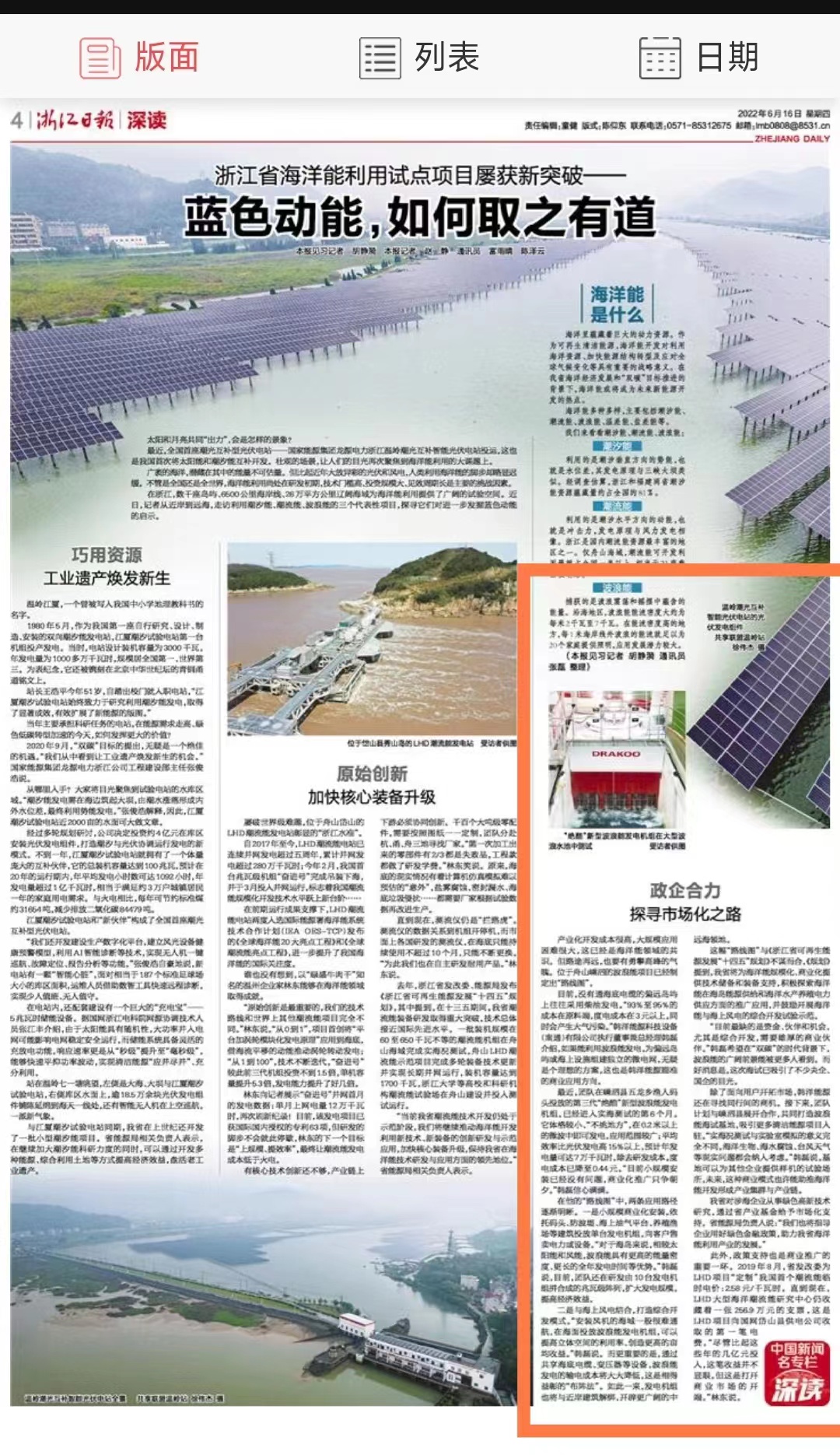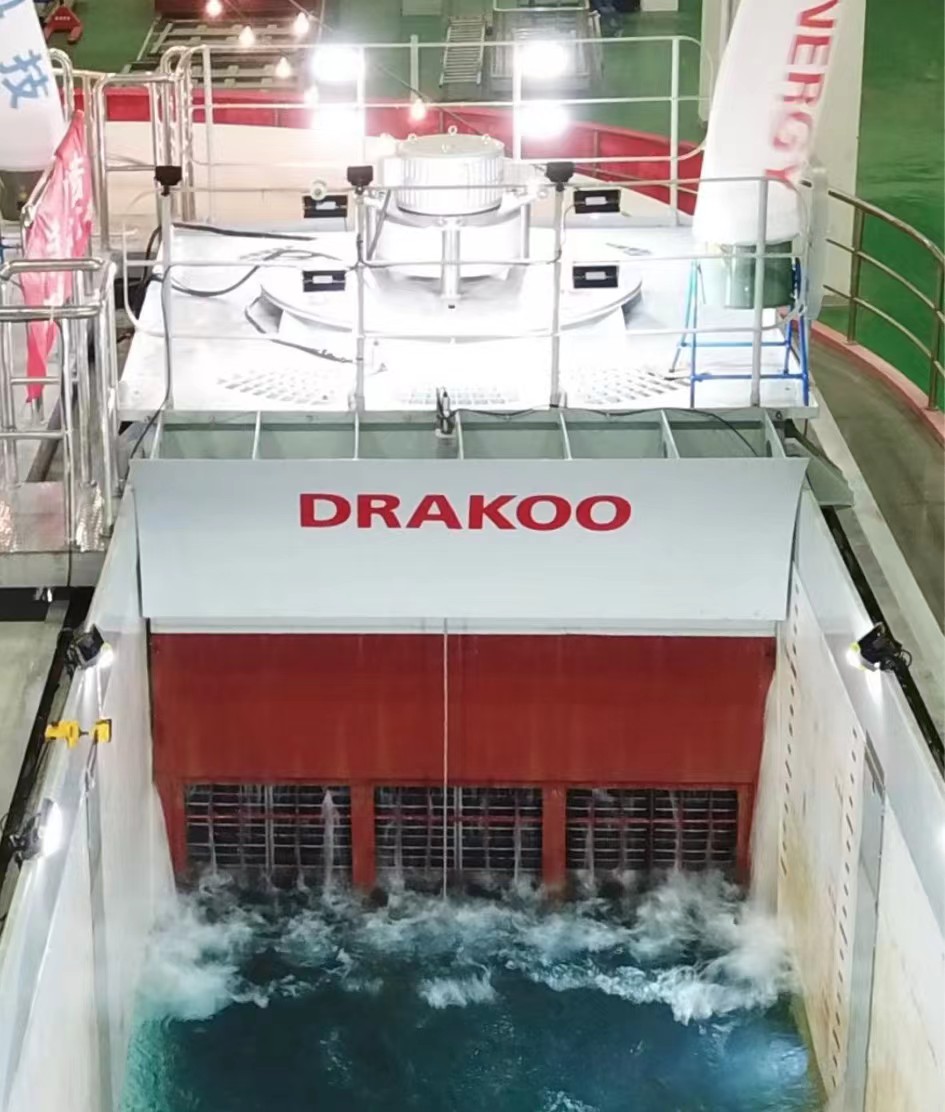Zhejiang Daily's Report on Hann-Ocean Energy's Wave Engergy Generation Technology and Market Prospects
21/06/2022
On June 16, Zhejiang Daily published a special report entitled "Blue Kinetic Energy, How to Take It", introducing the new breakthroughs achieved by the pilot projects of marine energy utilization in Zhejiang Province. Due to the smooth progress of the “Drakoo” wave energy generator sea trial in Shengsi, Zhejiang Daily interviewed Han Lei, executive director and general manager of Hann-ocean Energy and gave an extensive report on Hann-Ocean Energy's wave power technology and market prospect.

The following is the original report:
Wave Energy: What is captured is the energy contained in the oscillations and sway of waves. In coastal areas, the density of wave energy flow is about 2 kW to 7 kW per meter. Where the energy flow density is high, every 1 meter of wave energy flow off the coastline is enough to provide lighting for 20 homes, and the application development potential is great.

Government and Enterprises Work Together
Explore the Road to Commercialization
Industrial development costs are very high, large-scale application of great difficulties, which has been the consensus of the field of marine energy. But no matter how far the road is, we must have the courage to climb the peak. The wave energy project in Shengsi, Zhoushan, has already developed a "roadmap".
Currently, diesel power is often used on remote islands without submarine cables. "93% to 95% of the cost is on the raw material side, and the cost of electricity is more than 3 yuan per kWh, which will also cause air pollution." Han Lei, executive director and general manager of Hann-ocean Energy Technology , introduced that it would undoubtedly be an ideal solution if wave energy could be used to generate electricity and set up independent microgrids for remote islands or offshore facilities, which is also the commercial application direction that Hann-ocean Energy aims at.
Recently, the team's third-generation "Drakoo" new wave energy generator launched at the Fisherman's Wharf in Wulong Township, Shengsi County, has entered its 6th month of sea trial. The equipment is small, " not picky in placement", and can generate electricity in microwaves above 0.2 meters, so it has a wide range of applications; its average efficiency is more than 15% higher than that of photovoltaic power generation, the annual power generation is expected to reach 70,000 kWh, in addition to the cost of research and development, the cost of kWh has dropped to 0.44 yuan. "At present, there is no problem with small-scale installation, commercial promotion is only a matter of time." Han Lei is full of confidence.
In his "roadmap", two application paths gradually became clear. The first is small-scale commercial installation, relying on docks, breakwaters, offshore oil and gas platforms, fisheries and other constructions to put a single generator set to sell electricity or equipment to customers. "For islands, wave energy has the advantages of higher energy density and longer year-round power generation time compared to solar and wind energy." Han Lei said the team is currently developing a megawatt array composed of 10 generator sets to expand the scale of power generation and improve economic efficiency.
The second is to combine with offshore wind power to create an integrated development model. "The sea area where the wind turbines are installed is generally difficult to navigate, and the wave energy generator set on the sea surface can improve the utilization of the three-dimensional space and create a higher average return per mu." Han Le said. More importantly, by sharing submarine cables, transformers and other equipment, the transmission cost of wave energy power generation will be greatly reduced, which is a complementary "layout method". In this way, the generator units will also be untied from the nearshore buildings, opening up a broader territory in the middle and distant sea.
This "roadmap" coincides with the "14th Five-Year Plan for renewable energy development in Zhejiang Province", which mentions that our province will provide technical reserves and equipment support for the scale and commercialization of marine energy, actively explore the promotion and application of marine energy in the energy supply of islands and the supply of marine aquaculture electricity, and encourage the comprehensive development pilot demonstrations of marine energy and offshore wind power. "What is most lacking at the moment is funding, partners and opportunities, especially for integrated development, which requires strong business partners." Han Lei hopes that in the context of the "double carbon" era, the broad prospects of wave energy can be seen by more people. The good news is that this sea trial has attracted the attention of many central enterprises and state-owned enterprises.
In addition to opening up the market for users, Hann-Ocean Energy is also looking for business opportunities among its peers. Next, the team plans to cooperate with Shengsi County to jointly build a wave energy sea trial base and attract more clean energy projects. "The significance of live sea trials and laboratory simulations is completely different, and realistic issues such as marine life, seawater corrosion, typhoon weather and so on are taken into consideration." Han Lei said that the base can provide a testing site for other enterprises to prototype, and in the future, this business model may be able to boost the development of marine energy to form industrial clusters and industrial chains.
For more information, please refer to http://zjrb.zjol.com.cn/html/2022-06/16/content_3563512.htm?div=-1